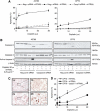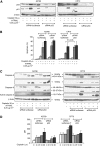Drug-induced caspase 8 upregulation sensitises cisplatin-resistant ovarian carcinoma cells to rhTRAIL-induced apoptosis
- PMID: 21487429
- PMCID: PMC3078595
- DOI: 10.1038/bjc.2011.84
Drug-induced caspase 8 upregulation sensitises cisplatin-resistant ovarian carcinoma cells to rhTRAIL-induced apoptosis
Abstract
Background: Drug resistance is a major problem in ovarian cancer. Triggering apoptosis using death ligands such as tumour necrosis factor-related apoptosis inducing ligand (TRAIL) might overcome chemoresistance.
Methods: We investigated whether acquired cisplatin resistance affects sensitivity to recombinant human (rh) TRAIL alone or in combination with cisplatin in an ovarian cancer cell line model consisting of A2780 and its cisplatin-resistant subline CP70.
Results: Combining cisplatin and rhTRAIL strongly enhanced apoptosis in both cell lines. CP70 expressed less caspase 8 protein, whereas mRNA levels were similar compared with A2780. Pre-exposure of particularly CP70 to cisplatin resulted in strongly elevated caspase 8 protein and mRNA levels. Caspase 8 mRNA turnover and protein stability in the presence or absence of cisplatin did not differ between both cell lines. Cisplatin-induced caspase 8 protein levels were essential for the rhTRAIL-sensitising effect as demonstrated using caspase 8 small-interfering RNA (siRNA) and caspase-8 overexpressing constructs. Cellular FLICE-inhibitory protein (c-FLIP) and p53 siRNA experiments showed that neither an altered caspase 8/c-FLIP ratio nor a p53-dependent increase in DR5 membrane expression following cisplatin were involved in rhTRAIL sensitisation.
Conclusion: Cisplatin enhances rhTRAIL-induced apoptosis in cisplatin-resistant ovarian cancer cells, and induction of caspase 8 protein expression is the key factor of rhTRAIL sensitisation.
Figures






Similar articles
-
Downregulation of active caspase 8 as a mechanism of acquired TRAIL resistance in mismatch repair-proficient colon carcinoma cell lines.Int J Oncol. 2010 Oct;37(4):1031-41. doi: 10.3892/ijo_00000755. Int J Oncol. 2010. PMID: 20811726
-
Enhanced antitumor efficacy of a DR5-specific TRAIL variant over recombinant human TRAIL in a bioluminescent ovarian cancer xenograft model.Clin Cancer Res. 2009 Mar 15;15(6):2048-57. doi: 10.1158/1078-0432.CCR-08-1535. Epub 2009 Mar 10. Clin Cancer Res. 2009. PMID: 19276284
-
Nutlin-3 preferentially sensitises wild-type p53-expressing cancer cells to DR5-selective TRAIL over rhTRAIL.Br J Cancer. 2013 Nov 12;109(10):2685-95. doi: 10.1038/bjc.2013.636. Epub 2013 Oct 17. Br J Cancer. 2013. PMID: 24136147 Free PMC article.
-
Resistance to TRAIL-induced apoptosis in ovarian cancer cell lines is overcome by co-treatment with cytotoxic drugs.Gynecol Oncol. 2004 Jul;94(1):107-14. doi: 10.1016/j.ygyno.2004.04.012. Gynecol Oncol. 2004. PMID: 15262127
-
Induction of death receptor ligand-mediated apoptosis in epithelial ovarian carcinoma: The search for sensitizing agents.Gynecol Oncol. 2009 Dec;115(3):438-42. doi: 10.1016/j.ygyno.2009.09.007. Epub 2009 Oct 4. Gynecol Oncol. 2009. PMID: 19804900 Free PMC article.
Cited by
-
Polymorphisms in the Gene Encoding Caspase 8 May Predict the Response to First-Line Platinum-Based Chemotherapy in Locally Advanced or Advanced Non-Small-Cell Lung Cancer.J Clin Med. 2021 Mar 8;10(5):1126. doi: 10.3390/jcm10051126. J Clin Med. 2021. PMID: 33800294 Free PMC article.
-
A novel allogeneic off-the-shelf dendritic cell vaccine for post-remission treatment of elderly patients with acute myeloid leukemia.Cancer Immunol Immunother. 2018 Oct;67(10):1505-1518. doi: 10.1007/s00262-018-2198-9. Epub 2018 Jul 23. Cancer Immunol Immunother. 2018. PMID: 30039426 Free PMC article. Clinical Trial.
-
The non-apoptotic function of Caspase-8 in negatively regulating the CDK9-mediated Ser2 phosphorylation of RNA polymerase II in cervical cancer.Cell Mol Life Sci. 2022 Nov 18;79(12):597. doi: 10.1007/s00018-022-04598-3. Cell Mol Life Sci. 2022. PMID: 36399280 Free PMC article.
-
Luteinizing hormone inhibits cisplatin-induced apoptosis in human epithelial ovarian cancer cells.Oncol Lett. 2016 Mar;11(3):1943-1947. doi: 10.3892/ol.2016.4122. Epub 2016 Jan 18. Oncol Lett. 2016. PMID: 26998105 Free PMC article.
-
Overcoming resistance to TRAIL-induced apoptosis in solid tumor cells by simultaneously targeting death receptors, c-FLIP and IAPs.Int J Oncol. 2016 Jul;49(1):153-63. doi: 10.3892/ijo.2016.3525. Epub 2016 May 16. Int J Oncol. 2016. PMID: 27210546 Free PMC article.
References
-
- Abedini MR, Muller EJ, Brun J, Bergeron R, Gray DA, Tsang BK (2008) Cisplatin induces p53-dependent FLICE-like inhibitory protein ubiquitination in ovarian cancer cells. Cancer Res 68: 4511–4517 - PubMed
-
- Abedini MR, Qiu Q, Yan X, Tsang BK (2004) Possible role of FLICE-like inhibitory protein (FLIP) in chemoresistant ovarian cancer cells in vitro. Oncogene 23: 6997–7004 - PubMed
-
- Agarwal R, Kaye SB (2003) Ovarian cancer: strategies for overcoming resistance to chemotherapy. Nat Rev Cancer 3: 502–516 - PubMed
-
- Ashkenazi A, Holland P, Eckhardt SG (2008) Ligand-based targeting of apoptosis in cancer: the potential of recombinant human apoptosis ligand 2/tumor necrosis factor-related apoptosis-inducing ligand (rhApo2L/TRAIL). J Clin Oncol 26: 3621–3630 - PubMed
-
- Ashkenazi A, Pai RC, Fong S, Leung S, Lawrence DA, Marsters SA, Blackie C, Chang L, McMurtrey AE, Hebert A, DeForge L, Koumenis IL, Lewis D, Harris L, Bussiere J, Koeppen H, Shahrokh Z, Schwall RH (1999) Safety and antitumor activity of recombinant soluble Apo2 ligand. J Clin Invest 104: 155–162 - PMC - PubMed
Publication types
MeSH terms
Substances
LinkOut - more resources
Full Text Sources
Medical
Research Materials
Miscellaneous

